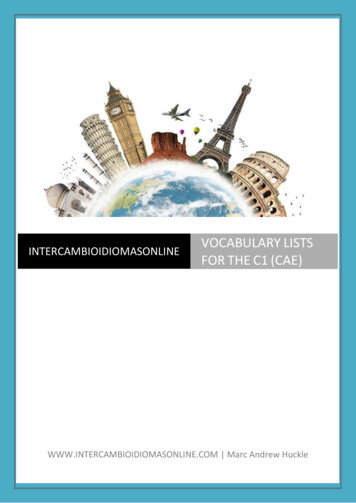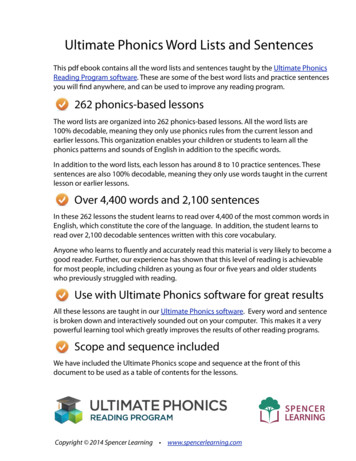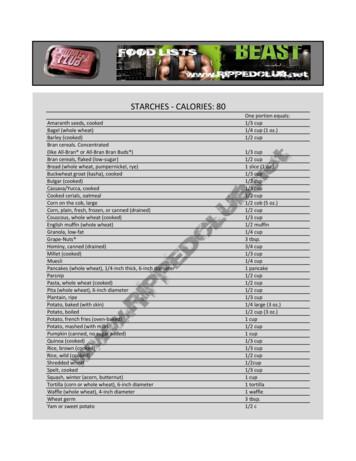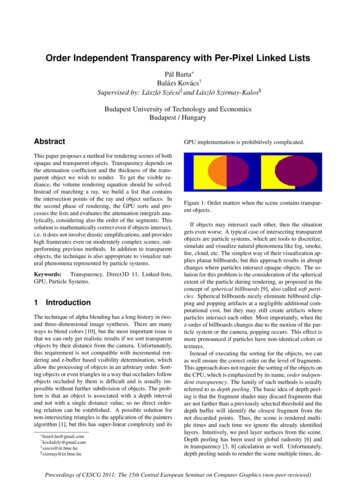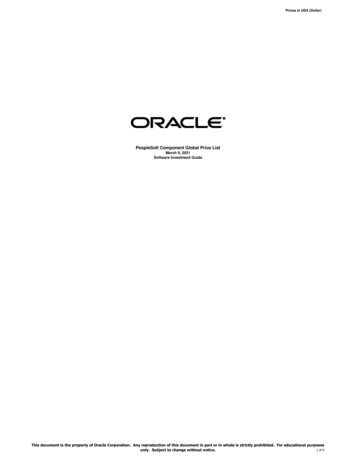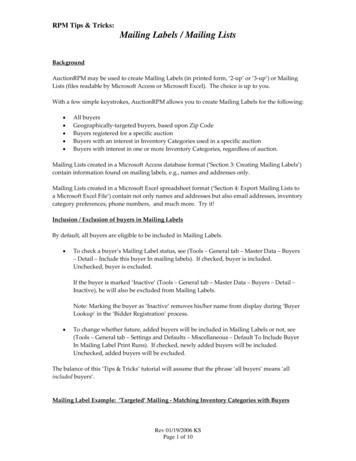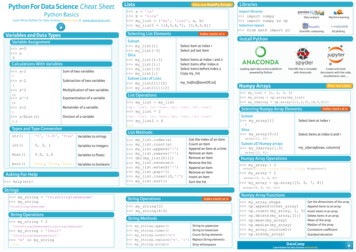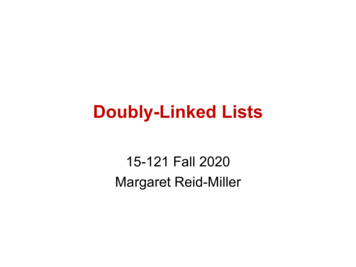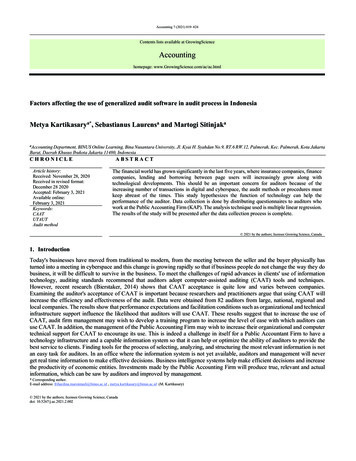
Transcription
Accounting 7 (2021) 819–824Contents lists available at GrowingScienceAccountinghomepage: www.GrowingScience.com/ac/ac.htmlFactors affecting the use of generalized audit software in audit process in IndonesiaMetya Kartikasarya*, Sebastianus Laurensa and Martogi SitinjakaaAccounting Department, BINUS Online Learning, Bina Nusantara University, Jl. Kyai H. Syahdan No.9, RT.6 RW.12, Palmerah, Kec. Palmerah, Kota JakartaBarat, Daerah Khusus Ibukota Jakarta 11480, IndonesiaCHRONICLEArticle history:Received: November 28, 2020Received in revised format:December 28 2020Accepted: February 3, 2021Available online:February 3, 2021Keywords:CAATUTAUTAudit methodABSTRACTThe financial world has grown significantly in the last five years, where insurance companies, financecompanies, lending and borrowing between page users will increasingly grow along withtechnological developments. This should be an important concern for auditors because of theincreasing number of transactions in digital and cyberspace, the audit methods or procedures mustkeep abreast of the times. This study hypothesizes the function of technology can help theperformance of the auditor. Data collection is done by distributing questionnaires to auditors whowork at the Public Accounting Firm (KAP). The analysis technique used is multiple linear regression.The results of the study will be presented after the data collection process is complete. 2021 by the authors; licensee Growing Science, Canada1. IntroductionToday's businesses have moved from traditional to modern, from the meeting between the seller and the buyer physically hasturned into a meeting in cyberspace and this change is growing rapidly so that if business people do not change the way they dobusiness, it will be difficult to survive in the business. To meet the challenges of rapid advances in clients' use of informationtechnology, auditing standards recommend that auditors adopt computer-assisted auditing (CAAT) tools and techniques.However, recent research (Bierstaker, 2014) shows that CAAT acceptance is quite low and varies between companies.Examining the auditor's acceptance of CAAT is important because researchers and practitioners argue that using CAAT willincrease the efficiency and effectiveness of the audit. Data were obtained from 82 auditors from large, national, regional andlocal companies. The results show that performance expectations and facilitation conditions such as organizational and technicalinfrastructure support influence the likelihood that auditors will use CAAT. These results suggest that to increase the use ofCAAT, audit firm management may wish to develop a training program to increase the level of ease with which auditors canuse CAAT. In addition, the management of the Public Accounting Firm may wish to increase their organizational and computertechnical support for CAAT to encourage its use. This is indeed a challenge in itself for a Public Accountant Firm to have atechnology infrastructure and a capable information system so that it can help or optimize the ability of auditors to provide thebest service to clients. Finding tools for the process of selecting, analyzing, and structuring the most relevant information is notan easy task for auditors. In an office where the information system is not yet available, auditors and management will neverget real time information to make effective decisions. Business intelligence systems help make efficient decisions and increasethe productivity of economic entities. Investments made by the Public Accounting Firm will produce true, relevant and actualinformation, which can be saw by auditors and improved by management.* Corresponding author.E-mail address: frihardina.marsintauli@binus.ac.id , metya.kartikasary@binus.ac.id (M. Kartikasary) 2021 by the authors; licensee Growing Science, Canadadoi: 10.5267/j.ac.2021.2.002
820This study will show whether a technological approach can have an influence on auditor performance so that it is more efficientand effective. The aim of this research is to demonstrate that the performance expectancy, effort expectancy and social influencehas a significant influence on the usage of the General Auditing Software (GAS).2. Previous StudyAhmi and Kent (2012) stated that Generalized audit software (GAS) is a tool used by auditors to automate various audit tasks.(Singleton & Ph, 2006) stated the benefits of using Generalized Audit Software (GAS) are firstly to develop a number ofcomputerized anti-fraud audit procedures that are regularly executed against an organization's database, secondly to test internalcontrols embedded in them, third to be more efficient to meet all the responsibilities and duties assigned to the auditor. Thereare nine main factors affecting the use of GAS among external auditors using non-GAS as shown in Fig 1.Fig. 1. The structure of the factors influencing on the use of GAS among external authorsThis study uses the UTAUT model to analyze the factors that influence the use of GAS in the audit process in Indonesia. TheUTAUT model is the newest model discovered by Venkatesh et al. (2003) and this model is considered the most appropriatemodel. UTAUT shows that four core constructs are direct determinants of technology acceptance (intentional behavior) and use(behavior): Performance Expectations, Business Expectations, Social Influence, and Facilitation of Conditions. According toresearch (Kim, Kotb, & Eldaly, 2016; Algharibi & Arvanitis, 2011) the impact of GAS features on actual use of GAS is similarin the Egyptian external audit profession. When they use the basic features of GAS which have low conceptual complexity, theyuse them more often and spend more time on them. They consider that the features are more useful and easier to use than GASfeatures with high conceptual complexity (Dwirandra, 2015; Rosli, 2012). Kim et al. (2016) found GAS is useful wheninfluenced by colleagues, supervisors, or organizations whereas internal auditors consider that GAS is easy to use wheninfluenced by support, training, or management support and useful when influenced by cognitive factors associated with theresult of GAS. In contrast, the impact of GAS features on actual use of GAS is similar in the Egyptian external audit profession.When they use the basic features of GAS that have low conceptual complexity, they use them more often and spend more timeon them. They consider that the features are more useful and easier to use than GAS features with high conceptual complexity.As the conceptual complexity of GAS features increased, perceived ease of use had a stronger effect on the use of GAS byEgyptian external auditors. Wicaksono and Lusianah (2016) found that the use of GAS has a positive impact on auditorperformance. Based on information, the use of GAS has a positive impact on the components of Work Quantity (amount ofwork completed in a certain period), Quality of Work (quality of work according to specified standards), Job Knowledge(knowledge of work and matters of responsibility) , Creativity (creativity to create solutions to problems that arise in work),Dependency (Awareness of completion of work to be done), Personal Qualities (qualities of workers which include personality,leadership, attitude and integrity in everyday life). Constructed from those previous studies, the hypotheses of this research are:H1: Performance expectancy has a significant influence on the usage of the General Auditing SoftwareH2: Effort expectancy has a significant influence on the usage of the General Auditing SoftwareH3: Social influence has a significant influence on the usage of the General Auditing SoftwarePerformance ExpectancyBehavioral Intention to UseGeneral Audit SystemEffort ExpectancySocial InfluenceFig. 2. The research method
M. Kartikasary et al. /Accounting 7 (2021)821The population used in this study are auditors who work at the Public Accounting Firm in Indonesia as respondents to determinethe factors that influence the interest in using audit techniques around computers. The study uses nonprobability sampling as amethod of determining the sample, with certain criteria or considerations as a sampling technique, namely purposive samplingtechnique. These criteria are auditors who have worked for at least one year or more and have audited financial statements withthe aim that the sample taken understands and is familiar with auditing around computers.The definitions of the variables analyzed in this study are:1.2.3.4.Performance expectations (X1), is a level of confidence in an individual in using and using the system so thatperformance can increase (Venkatesh et al. 2003). In this study, performance expectations were measured by 5questions.Business expectations (X2), is associated with the efficiency and effectiveness as well as the ease with which users cando a job (Pratama, 2008). According to Venkatesh and Davis, (2000) a very easy use of information technology willreflect a person's feelings about the system itself and lead to the use and use of the system. In this study, businessexpectations were measured by 6 questions.Social influence (X3), is an environment where other people can believe an individual that the use and utilization of asystem can be influenced or the environment seems to convince that a system must be used (Venkatesh et al. 2003). Inthis study, social influence was measured by 5 questions.Interest in using audit techniques around computers (Y), is a level of desire or intention of users in using and utilizingauditing around computers (Venkatesh et al. 2003). Interest in using audit techniques around the computer to be studiedis measured by 5 questions. The questionnaire used was adopted and modified as necessary according to the needs ofresearchers from the research of Handayani (2005) and Venkatesh et al. (2003) as measured by a four-point scale,namely a 4-Likert scale.The research design of this thesis is a quantitative study with primary data using a questionnaire to gain complete knowledgeabout the participants' thoughts on UTAUT in GAS. Participant demographics including titles, experience and positions inaccounting firms will produce a suitable sample for this study. The population in this study were all auditors who worked at theaccounting firm in Jakarta, Indonesia. This study used a purposive sampling method with more than one year of work experiencein the assurance team.Table 1Operational VariablesVariableIndependentPerformance expectancyEffort ExpectancySocial InfluenceDependentBehavioral Intention to use General Audit SystemDimensionNotationScaleInstrumentThe usageThe easiness of interactionEasiness perceptionThe easiness of interactionEasy to useMotivationEasiness perceptionEasiness perceptionPerformanceAccuracyEasiness perceptionPeople FactorsPeople FactorsFriends FactorsPeople FactorsFriends tionnaireTo use more oftenEasy to usePlanning to useTo use more oftenTo use more requestionnaire3. Result & DiscussionThis research is using a purposive sampling that based on the criteria with total samples of 74 participants with the detail ofsamples calculation as of follows:
822Table 2Research SamplesTotal questionnaire participantsNot suitable with the criteriaTotal Samples82774The samples required experience in assurance more than a year and profession as an auditor therefore there are 7 samples thatare categorized as “not suitable with the criteria” based on the requirements.3.1 Validity TestThis research is using SPSS to run the validity test and using Bivariate Pearson correlation for each one the other question inthe questionnaire. Table below demonstrates the validity for each one question:Table 3Validity alidValidBased on the table above, showed that with the t-table in the number of approximately 74 samples with 5% tolerance as 0,235,all the indicators are valid that can be used for further statistical tests.3.2 Reliability TestReliability testing uses the Alpha Cronbach formula because this research instrument is in the form of a questionnaire. If alpha 0.90, reliability is perfect. If alpha is between 0.70 - 0.90, the reliability is high. If alpha is 0.50-0.70, the reliability is moderate.If alpha 0.50 then reliability is low. If alpha is low, there may be one or more unreliable items.Table 4Reliability TestVariablePerformance Expectancy (X1)Effort Expectancy (X2)Social Influence (X3)General Audit Software (Y)Cronbach’s Alpha0,7410,8690,8510,894N of Items5655DescriptionHighHighHighHighTable 4 above is showing to the research that the samples are reliable (with all Cronbach’s alpha as high category) and can beused for further statistical tests.3.3 Statistical testIn order to test the hypothesis, a statistical test is a must in quantitative research. Therefore, the statistic test of this research isgiven in Table 5 as follows,
M. Kartikasary et al. /Accounting 7 (2021)Table 5The results of R-Square, Adjusted R-SquareModelRR Square10.909a0.827823Adjusted R Square0.819Std. Error of the Estimate1.24940a. Predictors: (Constant), X3, X1, X2Table 5The results of ANOVA test (Continued)ModelRegressionResidualTotalSum of Square520.851109.271630.122df37073Mean Square173.6171.561F111.221Sig.000ba. Dependent Variable: Yb. Predictors: (Constant), X3, X1, X2Table 5The results of regression analysis (Continued)Model1(Constant)X1X2X3a. Dependent Variable: YUnstandardized CoefficientsBStd. d ig.880.253.012.000The above tables convey that the independent variables have almost explained the dependent variables with adjusted R-square81,9% and with the sig. of 5% the model has fitted to the data set and the independent variables significantly influence thedependent variable simultaneously.The result of the t-test from the table above is showing that the X1 which is performance expectancy did not influence (sig 5%) the use of general audit software. The researcher acknowledges the usage of general audit software requires experience andthe auditor has to have a strong logic to run the software analysis, nevertheless, this can be taught and learned along the workof the assurance. The X2 (effort expectancy) and X3 (social influence), both of them influence the using of general audit softwaresignificantly (sig 5%). In the work of assurance nowadays, value added auditors are more respected than others, the usage ofgeneral audit software can bring such a value added to the clients, because of the functions, details and the sophistication of theaudit software can speed up the work with the best quality5. ConclusionThis research has shown that the performance expectancy did not influence the use of General Audit Software significantly andboth effort expectancy and social influence have influenced the use of General Audit Software. This research can benefit theauditors to always use General Audit Software to improve and accelerate the daily audit work by using audit software and thisnew way of work can be influenced among the peers or enforced from the accounting firm itself to their auditors.ReferencesAhmi, A., & Kent, S. (2013). The utilisation of generalized audit software (GAS) by external auditors. Managerial AuditingJournal, 28(2), 88-113.Algharibi, A. J., & Arvanitis, T. N. (2011, July). Adapting the Unified Theory of Acceptance and Use of Technology (UTAUT)as a tool for validating user needs on the implementation of e-Trial software systems. In Proceedings of HCI 2011 The 25thBCS Conference on Human Computer Interaction 25 (pp. 526-530).Bierstaker, J., Janvrin, D., & Lowe, D. J. (2014). What factors influence auditors' use of computer-assisted audit techniques?.Advances in Accounting, 30(1), 67-74.Dwirandra, A. A. N. B. (2015). ANALISIS FAKTOR-FAKTOR YANG MEMPENGARUHI KOMPUTER Fakultas Ekonomidan Bisnis Universitas Udayana ( Unud ), Bali , Indonesia proses akuntansi merupakan objek dari bidang praktik audit .Perkembangan banyak tersimpan dalam media elektronik . Peran dari kom. 2, 395–408.Handayani, T., & Sudiana, S. (2015). Analisis penerapan model UTAUT (Unified Theory of Acceptance and Use ofTechnology) terhadap perilaku pengguna sistem informasi (studi kasus: sistem informasi akademik pada STTNASYogyakarta). Angkasa: Jurnal Ilmiah Bidang Teknologi, 7(2), 165-180.
824Kim, H. J., Kotb, A., & Eldaly, M. K. (2016). The use of generalized audit software by Egyptian external auditors: The effectof audit software features. Journal of Applied Accounting Research, 17(4), 456–478. https://doi.org/10.1108/JAAR-102015-0079Rosli, K. (2012). Computer-Assisted Auditing Tools Acceptance Using I-Toe : A New Paradigm.Singleton, B. T. (2006). Generalized Audit Software: Effective and Efficient Tool for Today’s IT Audits. 1–3.The Contribution of Computer Assisted Auditing Techniques (CAAT) and of the Business Intelligence Instruments in FinancialAudit. (2018). Academic Journal of Economic StudiesVenkatesh, V., Morris, M. G., Davis, G. B., & Davis, F. D. (2003). User Acceptance of Information Technology: Toward aUnified View. (C. Beath, Penyunt.) MIS Quarterly, 27(3), 425-478.Wicaksono, A., & Lusianah, L. (2016). Impact Analysis of Generalized Audit Software (GAS) Utilization to AuditorPerformances. Binus Business Review, 7(2), 131-136. 2021 by the authors; licensee Growing Science, Canada. This is an open access articledistributed under the terms and conditions of the Creative Commons Attribution (CC-BY)license (http://creativecommons.org/licenses/by/4.0/).
has a significant influence on the usage of the General Auditing Software (GAS). 2. Previous Study Ahmi and Kent (2012) stated that Generalized audit software (GAS) is a tool used by auditors to automate various audit tasks. (Singleton & Ph, 2006) stated the benefits of using Generalize
